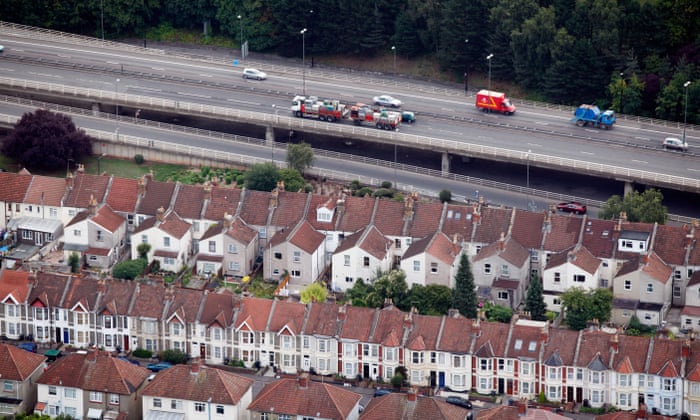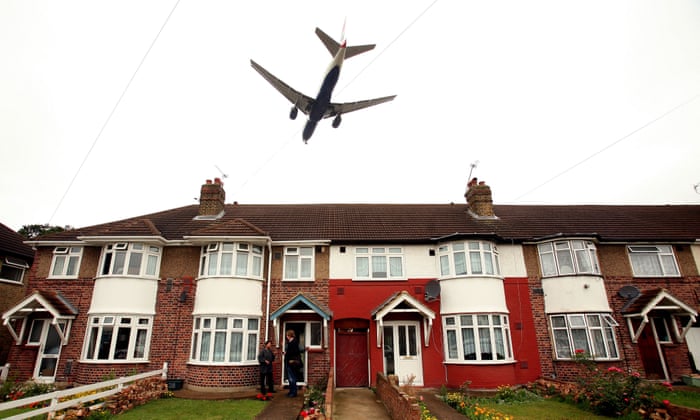Sonic doom: how noise pollution kills thousands each year
I never wanted to be the sort of person who got angry about noise. But there is something about noise that turns you into that person. One of the things that prompted our family to move from London to Bristol was our then three-year-old walking down our old road (Green Lanes in Haringey) going: “It’s so noisy!” It’s not simply that noise accelerates the grumpification process. It is a pollutant, with well-established effects on multiple aspects of physical and mental health, from cardiovascular disease to depression.
“There’s consistent evidence that road traffic noise leads to heart attacks,” says Dr Yutong Samuel Cai, an epidemiologist at Imperial College London. He recently analysed the health data of 356,000 people in Britain and Norway and found that long-term exposure to traffic noise affects our blood biochemistry, over and above the effects of exhaust fumes. “Noise and air pollution usually co-exist, but we can adjust our statistical model to factor out the air pollution. Noise seems to have its own effect on the cardiovascular system.” Another study, from Barts and the London School of Medicine, has linked noise pollution from road traffic to instances of type 2 diabetes. Cai stresses that more study is needed, for example, to quantify the different health impacts of constant low-frequency noise (a motorway) and intermittent peak noise (your neighbour playing techno at 3am). “There’s relatively little study of railway noise or airport noise, for example. But it is a growing area of research at the moment.”
The World Health Organization has calculated that at least 1 million healthy life-years are lost every year in western European countries because of environmental noise, with cardiovascular disease contributing to the vast majority of these deaths, especially high blood pressure, heart attacks and coronary heart disease. It is thought that noise triggers the release of the stress hormone cortisol, which damages blood vessels over time. Humans evolved our acute hearing millions of years ago, when we were prey animals and had to pinpoint predators, so it is no wonder we find noise stressful. It is hardwired. A leading acoustics engineer, Trevor Cox, hypothesises that the noises we find most stressful are distress calls – screams with an unhinged roughness to them, caused by the vibrations of the vocal folds when someone is truly terrified. The frequencies are similar to the archetypal horrible sound, fingers scraping down a blackboard; and to an electric drill angrily ripping through plasterboard.
Noise exposure has also been linked with cognitive impairment and behavioural issues in children, as well as the more obvious sleep disturbance and hearing damage. The European Environment Agency blames 10,000 premature deaths, 43,000 hospital admissions and 900,000 cases of hypertension a year in Europe on noise. The most pervasive source is road-traffic noise: 125 million Europeans experience levels greater than 55 decibels – thought to be harmful to health – day, evening and night. However, airport noise and railway noise cause more complaints – ask any of Boris Johnson’s constituents. Hacan, a campaign group for residents living under the Heathrow flight path, claims that 620,000 to 920,000 people are affected by noise from the airport – vastly more than for any other airport in Europe.
While epidemiologists are still quantifying the different effects of noise irritants, there are certain legal distinctions, says Tony Lewis of the Chartered Institute of Environmental Health. Ambient noise from cars and aeroplanes is in a different category from “noise nuisance” – which is defined as “an unlawful interference with a person’s use or enjoyment of land or some right over it, or in connection with it” in the 1990 Environmental Protection Act. “Road traffic by definition can’t be a noise nuisance,” he says. Noise is subjective: people have different thresholds of what they’re able to withstand. It’s also intimately entwined with social relations. People tend to be more irritated by noises that come from unpredictable human sources (loud music, loft conversions and tanked-up England fans) than predictable impersonal ones (roads).
In the case of noise nuisances, people are better protected than they imagine, says Lewis. “You have the right to a reasonably quiet environment. So, you can complain to your neighbour, to the local authority or even directly to the local magistrate court.” If you make a valid complaint to the council, they are legally obliged to act – usually by issuing a noise abatement notice. “Your neighbour will then have to show what measures they have taken to abate whatever the noise is. It might be to restrict the hours of work. It might be to stop it altogether. It might be to set a noise limit. It might be to take measures to isolate one property from another. There are options. You shouldn’t have to worry about it. Give the problem to your local authority – that’s what they’re there for.” (Ha!)
Many people do; there were more than half a million noise complaints to councils last year. “Councils receive more complaints about noise than any other issue,” says Lewis. “And it is a growing problem.” Kensington and Chelsea in London received the most: it had 13,790 complaints in 2016, the equivalent of more than 87 for every 1,000 inhabitants. Basement extensions and street music were the main issues; I used to work on Kensington High Street and I’m pretty sure I could identify the busker responsible.

'There’s consistent evidence that road traffic noise leads to heart attacks’: housing in Bristol next to a busy motorway. Photograph: Alamy Stock Photo.
Unsurprisingly, all of the loudest areas are in cities; it is well established that the more densely populated an area is, the more complaints there will be. Britain’s urban population is rising fast and so are their expectations. “It has a lot to do with property prices,” says David O’Neill, director of ION Acoustics in Bristol, which advises clients on how to manage noise. “If you’ve paid hundreds of thousands of pounds for a flat, you expect a certain level of quiet. Even if you’ve made the choice to buy it in the centre of town.” Indeed, noise complaints from residents of bijou new apartment blocks are now imperilling historic music venues and pubs in many British city centres: a handful of noise complaints often spells closure. We may think we all inhabit the same space, but the number of people walking around with iPhone earbuds and noise-cancelling headphones attests to how much we’re becoming habituated to our own virtual sound-worlds.
“We’re becoming a lot more intolerant as a society,” says Lewis. “We viciously protect our own individual rights and we’re increasingly intolerant of our neighbours and the way that they live. But there’s also an increasing recognition that noise can be managed and people now expect it to be managed.”
With regards to road traffic noise, however, there are not so many options. There is no specific enforceable limit in relation to traffic noise. It is usually left to the market to sort out, in so far as houses by busy roads tend to be cheaper; it may be a pay-off you are willing to consider. “Caveat emptor – let the buyer beware – very much applies here,” says Lewis.

Airport noise and railway noise cause more complaints than road noise. Photograph: Graeme Robertson for the Guardian
I head down to Eastville, a district of Bristol I occasionally zoom above at 50mph, as the M32 snakes overhead. According to Defra’s noise map, this is the loudest part of the city – volumes reach the75dB. It does not bother you much when you’re mooching around Ikea. But for the residents of Stapleton Road – once termed “Britain’s Most Dangerous Street” for the levels of street crime and prostitution towards its eastern end – it is the sound of everyday life.
I park my car by the Shah Jalal Jame mosque; its minarets pop up over the flyover. The sound here isn’t as bad as I thought it might be: the elevation of the motorway raises it above the level of the houses, reducing noise to an ambient zhoom. There are a few well-kept side streets lined with lime trees and a fun-looking skate park in the undercroft. It’s also strikingly multicultural – a few of the residents I approach don’t speak English. One says she simply tunes out the cars. Another says she’s more bothered by the noise from the skate park than from the motorway.
Elaine, 37, lives in one of the many houses that are divided into individual flats. “It doesn’t affect me so much, as I live at the back of the house,” she says. There’s a little garden out the back and it’s really quiet. When I came to view the property, it was a concern of mine. I have suffered with mental health in the past and the busy-ness of things can affect your thinking and be overwhelming. But I grew up next to the A1, so I’m used to it,” she says.
Clifford, 76, a retired police officer on nearby Napier Street, invites me into his house to demonstrate how much of a difference his double glazing makes. It’s almost silent. “There’s nothing you can do other than double glazing,” he says. “I don’t open my lounge windows and rarely the one in my bedroom, because I’m aware of all the rubbish coming down.” It was so hot that he had opened his bedroom window the night before. “There was this constant zum zum zum.” But to some extent, the seasons mitigate the worst effects: “When the trees are in leaf, it makes a big difference to the noise; when they’re bare, the noise comes straight across, especially at night,” he says. You don’t mind closing your windows so much in the winter. But this was an aspect of the house that Clifford factored in when he bought it.
“When I arrived in Bristol in 1990, I had a place at the top of [quite posh] Redland Road, which I soon realised was too expensive for me, as I didn’t have sufficient work coming in,” he says. “So, I sold that and bought this. Hated it at first. But it’s actually the best thing I ever did. They’re far more friendly around here. It’s a good little house, just for me.”
But as I head back down Stapleton Road, past the M32 Cafe, the noise becomes steadily more cacophonous. There’s a small section of Stapleton Road marooned from the rest by the junction of the M32 and B4469; vehicles are accelerating up the slip roads, careering round the roundabout and tearing down the motorway. Almost all of the houses here are divided into multiple flats. A landlord goes from building to building with a large bunch of keys; he tells me he gets more grief about commuters from outside Bristol taking advantage of the street’s free parking than the noise.
I meet one resident, Daisy Vazquez, who is Ecuadorian and in her 30s, on her way home with a suitcase. She has lived here for a year and a half and has not managed to tune the noise out. “It’s impossible,” she says. “All the day you hear the noise.” It dies down a bit between 2am and 5am. “But the worst part is when they do roadworks at night.” She usually keeps her windows shut, but it is no fun in hot weather and even in winter the lack of ventilation causes condensation problems. She is a light sleeper and worries about the effects on her health. “It’s unpredictable. You don’t know when you are not going to sleep. And I don’t know how it would affect you longterm.”
Cai, who conducted the Imperial study into road-traffic noise and health, stresses that one compounding factor is inequality. Houses next to busy roads tend to be cheaper. The people who live in them tend to be on lower incomes and have fewer choices. And people on lower incomes tend to have more health problems. Researchers will adjust their statistical models to take account of these socioeconomic factors when considering the effects of noise. We live in a world where peace and quiet is increasingly a luxury item and noise and stress are baseline conditions for the disadvantaged.

‘The worst part is when they do roadworks.’ Photograph: Alamy Stock Photo
“In the past two or three years, the links between noise pollution and mental health are becoming clearer,” says Cai. “It seems to be motivated by both sleep disturbance and noise annoyance, which varies from person to person.” He points to a 2015 German study that found that people living next to noisy roads were 25% more likely to have symptoms of depression than people in quieter areas, even when adjusting for socioeconomic factors. As Kate Pickett and Richard Wilkinson demonstrate in the book The Inner Level, pretty much any social problem worsens the more unequal a society is. US studies have shown that the more economically divided and racially segregated a city is, the louder it is for everyone – even the comparatively advantaged. It’s also true that the more disadvantaged you are, the louder your life will be, creating what researchers term a “double jeopardy” effect.
“We can also reasonably assume that there are particular groups that are at higher risk than others,” says Michael Eade of the campaign group Noise Nuisance. “Those people who already have fragmented sleep patterns experience heightened effects, making them more vulnerable. Such groups include the elderly, pregnant women, those already experiencing poor health and shift workers. While children have higher awakening thresholds than adults, making them less sensitive to noise, they experience a heightened effect from sleep disturbance.”
But this, he reflects, is by no means a new observation. He quotes the Roman poet Juvenal: “The sick die here because they can’t sleep / For when does sleep come in rented rooms? / It costs a lot merely to sleep in this city!” ARTICLE ENDS.

No comments:
Post a Comment
Note: only a member of this blog may post a comment.